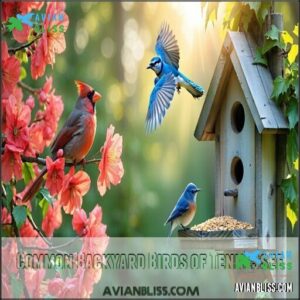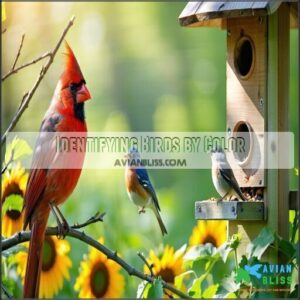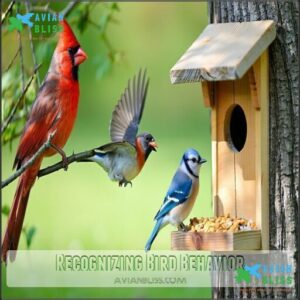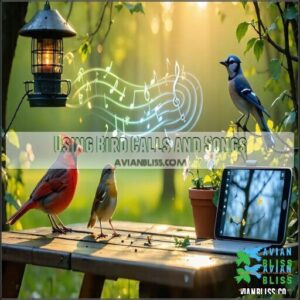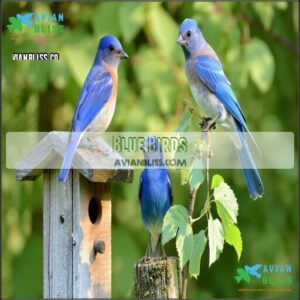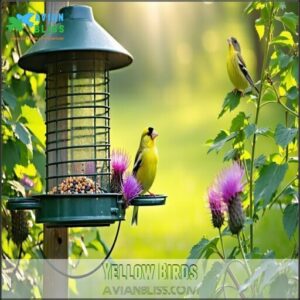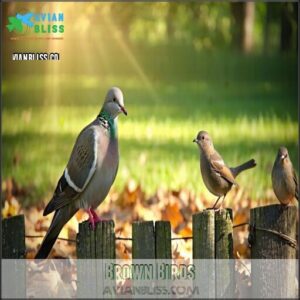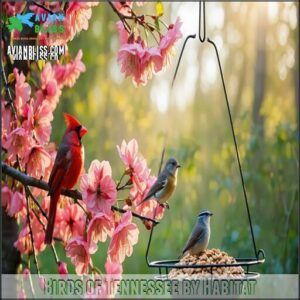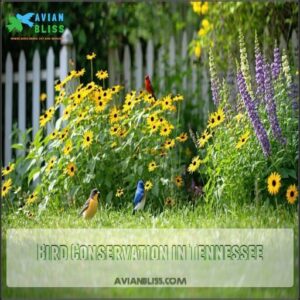This site is supported by our readers. We may earn a commission, at no cost to you, if you purchase through links.
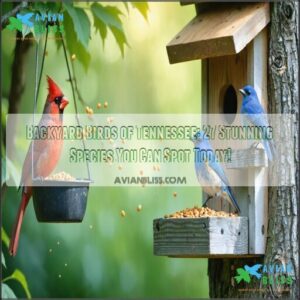
You’ll also spot Blue Jays squawking from treetops, Mourning Doves cooing softly, and Carolina Wrens zipping around like tiny acrobats.
Keep an eye out for Downy Woodpeckers tapping on tree trunks or the occasional Indigo Bunting lighting up your yard with its electric blue feathers.
To attract more feathered friends, try setting up feeders with sunflower seeds, suet, or mealworms.
Add a birdbath, and you’ll have a front-row seat to nature’s show.
Ready to meet your backyard neighbors?
Table Of Contents
- Key Takeaways
- Common Backyard Birds of Tennessee
- Identifying Birds in Your Backyard
- Most Common Backyard Birds in Tennessee
- Attracting Birds to Your Yard
- Birds of Tennessee by Color
- Birds of Tennessee by Habitat
- Using EBird for Birding in Tennessee
- Bird Conservation in Tennessee
- Birds of Tennessee by Season
- Contributing to Bird Research in Tennessee
- Frequently Asked Questions (FAQs)
- What is the Easiest Way to Identify Birds in Tennessee?
- Are There Any Bird-watching Events in Tennessee?
- How do I identify a bird in my backyard?
- What birds can you find in Tennessee?
- Which birds are found around your house?
- What birds are invasive in TN?
- What are the most common backyard birds in Tennessee?
- Which bird feeder attracts the most birds in Tennessee?
- Do birds eat native plants in Tennessee?
- Are mockingbirds common in Tennessee?
- Conclusion
Key Takeaways
- Set up feeders with black oil sunflower seeds, suet, or mealworms to attract common birds like Northern Cardinals, Blue Jays, and Eastern Bluebirds.
- Plant native shrubs like dogwood or elderberry to provide natural food and shelter, creating a bird-friendly habitat.
- Add a clean birdbath or moving water feature to your yard to attract more species and keep them hydrated year-round.
- Look for distinctive behaviors, colors, and songs to identify backyard birds like the vibrant Northern Cardinal or mimicry of the Northern Mockingbird, and observe their natural food sources.
Common Backyard Birds of Tennessee
You’ll find Tennessee backyards bustling with diverse bird species, including Northern Cardinals, Blue Jays, Eastern Bluebirds, and Carolina Wrens that bring color and song to your outdoor space.
These feathered visitors create a year-round wildlife show right outside your window, with each species displaying unique behaviors and feeding preferences that you can observe from the comfort of your porch or kitchen, enjoying the year-round presence of these birds.
Sparrows, Finches, and Allies
Tennessee’s sparrow and finch families bring color and song to your backyard bird sanctuary.
House Finches flash their crimson heads while American Goldfinches add sunny yellow splashes at your feeders.
For proper finch identification, note the House Sparrow’s chunky build and distinctive markings.
These birds have varied seed preferences – try black oil sunflower seeds for most species and thistle (nyjer) for goldfinches.
While some invasive finches like the House Sparrow have stable conservation status, native species benefit from consistent feeding.
Sparrow habitats include shrubby borders and low vegetation, making Tennessee birds easy to attract with the right setup.
Woodpeckers
Drummers of the forest world, woodpeckers bring distinctive rhythm and color to Tennessee backyards.
You’ll recognize them by their unique drumming behavior—rapid pecking that echoes through trees as they search for insects or establish territory.
- Red-bellied Woodpeckers: Despite their name, look for their bright red cap and zebra-patterned backs as they visit suet feeders.
- Downy Woodpeckers: These small, friendly visitors have distinctive black and white patterns with males sporting a red patch.
- Hairy Woodpeckers: Larger versions of Downys with longer bills and fewer black spots on their outer tail feathers.
Woodpecker diets include insects, nuts, and berries.
Their specialized nesting habits—creating cavities in trees—face challenges from habitat loss, making conservation efforts essential for their survival in Tennessee’s changing landscape.
Blackbirds, Doves, and Mockingbirds
While woodpeckers bring percussion to your backyard symphony, the blackbirds, doves, and mockingbirds add melody to Tennessee’s avian chorus.
You’ll spot Red-winged Blackbirds with their striking blackbird iridescence and scarlet shoulder patches, boldly announcing territories with their distinctive "conk-la-ree!" calls.
Mourning Doves, symbols of peace with their dove symbolism, gather quietly beneath feeders, cooing softly at dawn and dusk.
Northern Mockingbirds showcase impressive mockingbird mimicry, replicating other birds and even car alarms.
| Bird Species | Distinctive Features | Song Characteristics |
|---|---|---|
| Red-winged Blackbird | Glossy black with red epaulets | Bold, territorial "conk-la-ree!" |
| Mourning Dove | Soft brown, black spots on wings | Gentle, rhythmic cooing |
| Northern Mockingbird | Gray with white wing patches | Varied repertoire of copied songs |
| Common Grackle | Iridescent black with yellow eyes | Harsh, creaky calls |
| Brown Thrasher | Rusty brown, spotted breast | Double-noted phrases, mimics others |
Bluebirds, Robins, and Jays
Moving from the mellow mourners to the splash of color, Eastern Bluebirds brighten Tennessee yards with their brilliant blue feathers.
You’ll spot these cavity nesters checking out birdhouses—their preferred nesting spots.
American Robins hop across lawns hunting worms, their red-orange breasts standing out against green grass.
Their varied diet includes insects, berries, and fruits.
Blue Jays command attention with loud calls and striking blue plumage.
Don’t underestimate their intelligence—they’re known to use tools and remember food cache locations.
All three species are year-round Tennessee birds, making your backyard bird watching rewarding in any season.
Nuthatches, Wrens, and Kinglets
While Blue Jays bring vibrant colors, another group of Tennessee birds adds charm to your backyard.
Watch for these fascinating small birds:
- White-breasted Nuthatches scurry headfirst down tree trunks, showing unique feeding behavior
- Carolina Wrens build nests in unusual spots and fill your yard with loud "teakettle" songs
- Ruby-crowned Kinglets flash their red crest patches when excited
- Golden-crowned Kinglets hover like tiny helicopters while hunting insects in your evergreens
Identifying Birds in Your Backyard
You’ll find Tennessee’s backyard birds easier to identify when you focus on their size, colors, behaviors, and songs rather than trying to memorize field guides.
With practice, you’ll start noticing distinctive features like the Northern Cardinal’s bright red plumage or the Carolina Chickadee’s black cap and white cheeks, making each backyard sighting more rewarding.
Using Bird Size and Shape
When spotting backyard birds in Tennessee, size and shape are your first clues to identification.
Notice the relative size of birds—compare the tiny Carolina Chickadee (about 12 cm, 10 gm) to the imposing American Crow (40-53 cm, 320-620 gm).
Body shape reveals much too: Cardinals have stocky builds while Mourning Doves appear streamlined.
Watch for distinctive features like beak shape (seed-cracking conical beaks versus insect-hunting slender ones) and tail length (short or long).
Flight silhouettes are equally telling—woodpeckers undulate while bluebirds glide smoothly.
Here’s a quick reference:
Identifying Birds by Color
Color is your most powerful tool for identifying Tennessee’s backyard birds.
When you’re watching your feeders, focus on plumage patterns that make each species unique.
Look for these distinctive color characteristics:
- Northern Cardinals showcase brilliant red plumage on males, while females display subtle reddish accents on muted brown feathers
- Eastern Bluebirds combine stunning azure backs with warm orange-rusty breasts
- Carolina Chickadees wear distinctive black caps with crisp white cheeks
- American Goldfinches undergo dramatic seasonal changes, transforming from dull winter colors to bright yellow summer plumage
Remember that lighting conditions can affect how colors appear, so observe birds from different angles whenever possible.
Recognizing Bird Behavior
Recognizing five key bird behaviors will dramatically improve your Tennessee backyard bird identification skills.
Watch how birds interact with their environment to reveal their unique personalities.
| Behavior | Tennessee Species | What You’ll See |
|---|---|---|
| Feeding Habits | Northern Cardinals | Ground foraging, seed cracking |
| Flight Patterns | Blue Jays | Direct, purposeful flight between trees |
| Social Interactions | Chickadees | Taking turns at feeders, warning calls |
| Mating Rituals | Eastern Bluebirds | Males bringing nesting material, wing displays |
Notice woodpeckers’ distinctive drumming and vertical tree climbing. Observe American Robins’ characteristic "running then stopping" lawn behavior. Each species has behavioral signatures that you’ll soon recognize without even seeing colors, which will improve your backyard bird identification skills and help you understand their unique personalities.
Using Bird Calls and Songs
Listening is your secret weapon for identifying Tennessee birds. Their calls and songs tell stories you can’t see with your eyes alone. The Northern Cardinal’s "cheer-cheer-cheer" sounds different from the Carolina Wren’s loud "tea-kettle" calls.
For better Call Identification skills:
- Wonder at the Blue Jay’s impressive mimicry examples, including their spot-on hawk impressions
- Discover the unique regional dialects that make Tennessee birds sound slightly different than elsewhere
- Connect with nature as you learn the song meanings behind each chirp and trill
- Marvel at vocal learning abilities that let some species add new sounds to their repertoire
Recording backyard birds with your phone helps match sounds with species. Utilizing tools like the Merlin Bird ID app can further refine your identification.
Most Common Backyard Birds in Tennessee
You’ll spot a colorful array of birds in Tennessee yards, including Northern Cardinals with their bright red plumage, American Goldfinches sporting vibrant yellow feathers, and the striking blue of Eastern Bluebirds and Blue Jays.
These common visitors appear throughout the year at feeders stocked with black oil sunflower seeds, though you’ll need mealworms to attract bluebirds and peanuts for jays.
Northern Cardinal
Flashing like a crimson beacon among Tennessee birds, the Northern Cardinal captivates backyard enthusiasts year-round with its brilliant male plumage and sweet Cardinal Song.
This beloved visitor is easily recognized by:
- Distinctive appearance – Males sport vibrant red feathers while female Cardinals display subtle tan with reddish accents
- Cardinal Diet – They prefer black oil sunflower seeds above all other offerings
- Nesting Habits – Building cup-shaped nests in dense shrubs about 4-8 feet off the ground
- Courtship behavior – Males feed their mates beak-to-beak during courtship
- Territorial nature – They’ll fiercely defend their nesting areas, sometimes attacking their own reflections
You’ll hear their cheerful whistles throughout Tennessee neighborhoods all year long.
American Goldfinch
The sunshine-bright American Goldfinch brings year-round joy to Tennessee backyards.
These common residents can be spotted statewide, with numbers increasing during winter as northern birds join the locals. Unlike many backyard birds, they delay nesting until July when seed availability peaks for their primarily seed-based diet.
Their population remains stable throughout Tennessee, making them reliable visitors to your feeders. During summer, males display brilliant yellow plumage, while winter brings olive-brown tones.
For Attracting Goldfinches, offer Nyjer seeds and thistle feeders – they’ll reward you with their distinctive "po-ta-to-chip" calls and playful flocking behavior.
Indigo Bunting
During summer months, the Indigo Bunting transforms Tennessee landscapes with its spectacular all-blue plumage.
Unlike the Eastern Bluebird with its rusty belly, male buntings display complete electric-blue coloration, while females maintain brown camouflage for nesting safety.
These Tennessee birds thrive in shrubby borders and weedy fields throughout the state.
Listen for their distinctive paired phrases like "fire-fire, where-where" during bunting migration seasons.
Their diet consists mainly of seeds, making them easy to attract with sunflower offerings.
For successful Indigo Bunting ID and conservation, incorporate native plants in your yard to support their natural habitat needs.
Eastern Bluebird
The Eastern Bluebird brings joy to Tennessee yards with its brilliant blue plumage and rusty-orange breast.
Unlike the all-blue Indigo Bunting, this year-round resident sports a distinctive color pattern that makes it a favorite among backyard bird enthusiasts. You’ll often spot these beauties in open spaces with scattered trees.
- Bluebird Nesting: Position nest boxes 5-6 feet high, facing away from prevailing winds
- Bluebird Diet: Offer mealworms in platform feeders; they’ll become regular visitors
- Bluebird Habitat: Maintain short grass areas where they can hunt insects
Their gentle warbling songs and beneficial insect-eating habits make bluebird conservation efforts worthwhile for any Tennessee backyard.
Blue Jay
You’ll often spot Blue Jays in Tennessee backyards, showcasing their brilliant blue crest and bold personality.
These intelligent birds are year-round residents, with more northern jays joining the local population during winter.
Their characteristic "jay-jay" calls and hawk mimicry skills make them easy to identify.
Trait Details Interesting Fact
Size
Diet
Calls
Nesting
Role
Blue Jays display impressive social behavior and acorn dispersal habits.
They’re common from mid-September through May, contributing to habitat needs throughout Tennessee’s diverse landscapes.
Attracting Birds to Your Yard
You’ll transform your Tennessee yard into a bird sanctuary by offering the right mix of food, water, shelter, and nesting sites.
Native plants like dogwoods and berry bushes paired with clean feeders stocked with black oil sunflower seeds will attract colorful visitors from cardinals to chickadees.
Providing The Right Food
Now that you’ve met Tennessee’s common backyard visitors, let’s talk about filling their plates. Different birds have distinct seed preferences, so variety is key.
Black oil sunflower seeds work like magic for attracting cardinals, chickadees, and titmice, while safflower seeds deter pesky squirrels. For goldfinches, nothing beats nyjer thistle in specialized feeders that allow them to hang sideways.
Woodpeckers and nuthatches will flock to suet blocks, especially during winter months. These seeds are available for purchase at retailers.
Consider these feeder types for your yard:
- Tube feeders for smaller songbirds
- Platform feeders for cardinals and jays
- Suet cages for woodpeckers
Remember to adjust your offerings with seasonal feeding patterns—more protein-rich foods in spring and fatty foods in winter. Complement bird seeds with natural foods by planting native berry bushes. Regularly clean your feeders to prevent disease and keep Tennessee birds coming back.
Creating a Bird-Friendly Habitat
Now that you’ve got the right food ready, let’s create a welcoming space where Tennessee birds will feel right at home.
Transform your yard into a bird paradise by incorporating native plants that Tennessee birds naturally recognize and depend on. Your backyard becomes their sanctuary when you:
- Plant native trees and shrubs like dogwoods or serviceberries that provide natural food sources and nesting spots
- Create layered vegetation with trees, shrubs, and ground cover to mimic natural habitats and offer protection
- Include brush piles or fallen logs that serve as foraging areas for ground-feeding birds
Water sources are just as important as food—install a shallow birdbath away from predator hiding spots. Reducing pesticides protects birds and their insect food sources. Remember, bird habitat isn’t just about aesthetics—it’s about creating a safe environment where backyard birds can thrive naturally.
Installing Bird Feeders and Baths
Now that you’ve created a welcoming habitat, it’s time to set up the dining and bathing areas for your feathered guests.
Strategic feeder placement transforms your Tennessee backyard into a bird hotspot. Position feeders near trees for quick escape routes while keeping them visible for your enjoyment. Tube feeders filled with black oil sunflower seeds will attract chickadees and finches, while platform feeders bring in cardinals and jays.
Bath maintenance is simple but essential—refresh water every few days and scrub occasionally to prevent algae growth. Consider heated options for winterizing feeders and baths. Many people purchase backyard bird baths to attract more birds. In winter, consider heated options for winterizing feeders and baths.
- Place feeders at different heights to accommodate various species’ feeding preferences
- Use baffles or specialized feeders for preventing pests like squirrels
- Position birdbaths in partially shaded areas with nearby perches for safety
- Add moving water features to double your bird attraction potential
Remember, consistency is key—birds rely on your feeders once discovered!
Offering Nesting Sites and Roosting Boxes
After setting up feeders and baths, give Tennessee birds a place to call home with properly designed nesting sites and roosting boxes. Box placement is vital—install them 5-8 feet high in quiet, sheltered areas away from busy feeders. Tennessee’s native birds have specific roosting preferences, so match entrance hole sizes accordingly (1½ inches for bluebirds, 1¼ inches for chickadees).
A key element is to provide basic needs to guarantee birds find your yard appealing. This includes creating an environment that meets their essential requirements for survival and comfort.
- Use untreated wood for bird houses—cedar and pine work best as they resist weather damage
- Add predator guards below boxes to prevent raccoons, snakes, and cats from reaching nests
- Include proper ventilation and drainage holes to keep nests dry and comfortable
- Clean boxes annually in late winter to remove old nesting material and prevent parasite buildup
Regular box maintenance guarantees your feathered neighbors return year after year. By following these steps, you can create a welcoming environment for Tennessee birds and enjoy their presence in your yard.
Creating a Bird-Friendly Landscape
While transforming your yard into a bird paradise, incorporating native plants like dogwoods and coneflowers creates natural food sources that Tennessee birds instinctively recognize.
Layer your landscape with tall trees, mid-level shrubs, and ground cover to provide diverse shelter options that mimic natural habitats. A simple birdbath or small pond serves as an essential water source, attracting birds even when feeders are empty.
Consider adding a ceramic water feature to further enhance your backyard oasis. Position bird houses and roosting boxes in quiet areas safe from predators.
For truly bird-friendly spaces, eliminate pesticides that harm birds and their insect food sources. Complete your backyard bird sanctuary with strategically placed feeders offering black oil sunflower seeds and thistle.
You’ll soon enjoy colorful visitors fluttering through your thoughtfully designed space, creating a haven that is both beautiful and environmentally friendly.
Birds of Tennessee by Color
You’ll find Tennessee’s backyard birds in a rainbow of colors, from the bright red Northern Cardinal to the blue-crested Blue Jay.
Looking at birds by their color patterns helps you identify them quickly when they visit your feeder.
Blue Birds
Three stunning blue birds grace Tennessee’s backyards, each with distinctive features that make them a joy to spot. The Eastern Bluebird showcases vivid deep blue plumage with rusty-red throats and breasts, while females display more subdued coloring with bluish wings and gray upperparts. Indigo Buntings dazzle with their entirely blue appearance, unlike the Eastern Bluebird’s two-tone pattern. Blue Jays round out this colorful trio with their striking blue crest and bold personality.
- For successful Bluebird identification, look for their characteristic silhouette and flight pattern—they often perch prominently before swooping down for insects.
Bluebirds prefer open habitats with scattered trees. They’ll readily use properly positioned nesting boxes, especially when placed away from House Sparrow territories. Their diet includes insects and berries, making mealworm feeders particularly attractive to them.
With proper habitat management and feeding, you’ll enjoy these blue beauties year-round in your Tennessee backyard. They are a colorful trio and offer a striking blue appearance, making them a great addition to any backyard. The Eastern Bluebird’s vivid deep blue plumage is a notable feature, and their rusty-red throats and breasts are a distinctive characteristic.
Yellow Birds
While blue birds catch the eye with their sky-like plumage, Tennessee’s yellow birds bring sunshine to your backyard.
Yellow Warblers and Nashville Warblers show off bright yellow undersides, while Evening Grosbeaks display stunning yellow patterns.
You’ll find Yellow-Breasted Chats in dense thickets, and Prairie Warblers prefer wooded areas.
Magnolia Warblers feature the most distinctive patterns among Tennessee’s yellow birds.
Listen for their unique yellow bird songs and watch for movement in trees.
Goldfinch diet consists mainly of seeds, making feeders with thistle especially attractive to these yellow birds.
Red Birds
While yellow birds add sunshine to your yard, Tennessee’s red birds bring fiery drama to your backyard.
The Northern Cardinal tops the popularity list, with males flaunting brilliant red plumage—you’ll instantly recognize their distinctive crests and powerful beaks.
Summer Tanagers are among the few entirely red birds in Tennessee, making Cardinal identification straightforward.
Don’t miss the Scarlet Tanager with its black wings contrasting against bright red bodies.
House Finches display more subtle reddish crowns and breasts while delighting with their year-round melodies.
For best viewing success, offer black oil sunflower seeds and create habitat preferences that include dense shrubs and small trees.
Grey Birds
While cardinals bring splashes of crimson to your yard, Tennessee’s grey birds offer elegant, subtle beauty.
You’ll likely spot these common grey visitors:
- Dark-eyed Juncos – small, slate-gray birds with white bellies that hop along the ground searching for seeds
- Carolina Chickadees – recognizable by their black caps, white cheeks, and gray backs as they flit between feeders
- Tufted Titmice – distinctive gray birds with pointed crests that hang upside down from branches while foraging
Identifying these gray birds gets easier with practice as you notice their unique behaviors and habitats, and understand how to distinguish them by their distinctive features.
Brown Birds
Brown birds make up a significant portion of Tennessee’s backyard visitors, each with distinctive characteristics that make identification fascinating.
| Species | Identification | Habitat Preferences |
|---|---|---|
| Mourning Dove | Sandy-brown body, soft cooing | Open yards, feeding on ground |
| Brown Thrasher | Rusty color, yellow eyes, streaked breast | Thickets and brambles |
| Chipping Sparrow | Rusty cap, clear breast | Woodlands and suburbs |
| House Wren | Tiny size, upturned tail | Dense vegetation, nest boxes |
You’ll often spot House Sparrows darting between feeders – they’re actually invasive but common throughout Tennessee. When identifying sparrow varieties, note the bold streaks on Song Sparrows’ chests compared to their plainer cousins.
Carolina Wrens display interesting wren behavior, often hanging upside-down while foraging. For thrasher identification, look for their distinctively long, curved bills and striking yellow eyes – they’re larger than most common Tennessee backyard birds.
Birds of Tennessee by Habitat
You’ll find different bird species across Tennessee’s five main habitats: woodlands, backyards, water bodies, open fields, and urban areas.
Each habitat attracts specific birds, from woodpeckers in forests to cardinals in your yard.
Woodland Dwellers
Forests in Tennessee are brimming with avian activity, hosting a variety of charismatic species that thrive in woodland habitats.
These forest birds each play their role, whether scaling tree bark or filling the air with song.
From canopy species to understory birds, here’s what to watch for:
- Carolina Chickadee: Quick, chatty, and constantly on the go.
- Tufted Titmouse: Prefers sunflower seeds while flitting through trees.
- Northern Cardinal: Brings bold color to the greenery.
- White-breasted Nuthatch: Climbs trees headfirst like a pro climber.
- Downy Woodpecker: Often heard tapping for insects.
They also contribute to pest control efforts in the ecosystem.
Backyard Birds
Transform your yard into a lively backyard ecosystem by setting up bird feeders with black oil sunflower seeds, a favorite of Tennessee birds like cardinals and chickadees.
Plant native shrubs for shelter and encourage nesting behavior with well-placed birdhouses.
Add a bird bath for feather care during seasonal changes.
Enjoy bird photography and identifying species by listening carefully to unique bird songs!
Waterfowl and Waders
Waterfowl and waders bring charm to Tennessee’s wetlands and ponds.
Spotting these fascinating birds, like Mallards and Great Blue Herons, is easier with a little preparation.
- Duck Identification—recognize Mallards by their green heads and Canada Geese by their loud honks and black necks.
- Learn Goose Behavior—watch their intricate group landings during migration.
- Protect Heron Habitats—manage ponds with native plants to support these long-legged hunters.
- Promote Wetland Conservation—connect with groups like the Tennessee Audubon Society to sustain these critical bird habitats.
Birds of Open Fields
In Tennessee’s open fields, Eastern Meadowlarks bring charm with their cheerful songs.
These grassland birds rely on seeds and insects for their diets and nest on the ground, hidden within tall grasses.
Supporting their habitats means tackling open field threats like habitat loss or predation.
Plant native plants nearby and keep bird feeders low-profile to help them thrive.
Conservation efforts like these guarantee backyard bird enthusiasts can continue enjoying these iconic Tennessee birds for years to come.
Birds of Urban Areas
City birds prove remarkably adaptable, thriving amidst noise and light pollution. Tennessee’s urban skies often host local birds like the resilient House Sparrow and Northern Mockingbird.
Urban bird diets adapt to what they can scavenge, but you can help enhance their nutrition and overall safety.
To attract and protect backyard birds in cities, follow these tips:
- Install bird feeders with seeds or suet to help species like Chickadees, Cardinals, and Jays.
- Provide water sources, ensuring they’re clean and unfrozen year-round.
- Plant native shrubs to create green spaces for shelter and city nesting sites.
- Apply window decals to reduce deadly collisions, especially near feeders.
Creating bird-friendly spaces turns any backyard into a haven!
Using EBird for Birding in Tennessee
You can use eBird to record your bird sightings and track species in your area with ease.
It’s a powerful tool that helps both beginner and experienced birdwatchers contribute to bird conservation while exploring Tennessee’s rich birdlife. Complete concepts and separate lines.
Creating an EBird Account
Creating an eBird account is simple and opens up great perks for tracking Tennessee birds.
- Sign Up: Visit eBird.org or download the mobile app to register—free of charge!
- Customize: Adjust settings for data privacy and bird identification help.
- Explore: Use checklists, connect via community features, and track backyard birds effortlessly. You’ll love contributing to bird science!
Submitting Checklists
Submitting checklists to eBird turns your birdwatching into meaningful data.
Accuracy matters—confirm species, note behaviors, and include habitats to help document Tennessee birds.
Reporting frequent sightings, even of common backyard birds like Northern Cardinals, aids in tracking seasonal changes and rare finds.
Use eBird’s user-friendly app for precise location details and quick submissions.
Your contributions support bird identification, conservation impact, and community engagement.
Each checklist adds to a global effort, helping preserve Tennessee’s bird populations while making bird watching more rewarding for you and scientists worldwide, which is essentially citizen science in action!
Exploring EBird Data
Discover a new level of birdwatching with eBird, a free tool packed with incredible features to enhance your passion for Tennessee birds. It’s like having a bird encyclopedia and research lab in your pocket, helping you identify and celebrate the backyard birds you love.
eBird’s Data Visualization tools let you explore Species Distribution and migration patterns down to the season. You can track Abundance Trends and observe which birds are year-round guests or fleeting visitors, while Habitat Modeling shows where your favorite species thrive.
Here’s what you can do with eBird:
- Browse interactive maps to pinpoint species near you.
- Monitor bird migration live, right from home.
- Discover birding hotspots for your Tennessee adventures.
- Understand bird behaviors using visualized trends.
- Help conservation by contributing data through Citizen Science.
It’s all just a click away!
Using EBird for Bird Conservation
Turning your birdwatching into impactful action is easy with eBird.
This citizen science platform allows you to contribute to data-driven conservation by logging sightings of backyard birds and more across Tennessee.
Your entries support habitat monitoring, reveal species distribution, and aid in conservation planning.
Whether you’re tracking Northern Cardinals or spotting rare warblers, each observation fuels critical efforts to protect bird populations.
With eBird’s mapping tools, your data can spotlight areas needing attention.
Every sighting, big or small, plays a role in ensuring Tennessee’s birds thrive!
Participating in EBird Projects
Participating in eBird projects is an easy way to turn your bird watching in Tennessee into a conservation win.
This citizen science platform connects your backyard bird sightings to global research, helping conservation efforts while strengthening community engagement. By increasing checklist frequency and data accuracy, you’re directly impacting bird studies and migrations.
- Discover birding hotspots to find new species and better understand local bird habitats.
- Collaborate with others by sharing sightings in surveys or specialized projects.
- Support conservation by contributing data shaping meaningful research outcomes.
Every report makes a difference!
Bird Conservation in Tennessee
You can play a big role in protecting birds by creating safe, welcoming spaces right in your backyard.
Simple actions like reducing window collisions, supporting native plants, and joining local conservation programs make a lasting difference for Tennessee’s feathered friends, and by doing so, you support the well-being of the environment.
This can be achieved through simple actions.
Creating a Bird-Friendly Yard
A yard buzzing with backyard birds can feel like your own wildlife show. To invite feathered friends, embrace these simple tips.
Plant Native Plants like Dogwood or Coneflower. They’re nature’s vending machine—offering food and shelter while supporting a healthy bird habitat.
For thirsty visitors, add Water Features such as bird baths or fountains. Heated versions keep the drinks flowing, even in winter.
Create safe nesting spots with Shelter Options like dense shrubs or birdhouses. Place them high and away from predators. Speaking of safety, practice Predator Control—keep cats indoors and pruning minimal.
Fill bird feeders with black oil sunflower seeds, suet, or mealworms for instant attractions. Finally, Reduce Pesticides to protect their food sources.
| Feature | Why It Helps | Example |
|---|---|---|
| Native Plants | Food and shelter | Dogwood, Coneflower |
| Water Features | Essential for hydration | Bird baths, fountains |
| Shelter Options | Nesting and roosting sites | Birdhouses, dense shrubs |
| Predator Control | Safety from threats | Keep cats indoors |
Your yard could be a bird’s paradise before you know it!
Supporting Local Conservation Efforts
Supporting bird conservation in Tennessee starts with simple steps that make a big impact.
Join local organizations and tackle habitat preservation by planting native species and reducing pesticides to protect natural food sources. Bird habitats thrive when wildlife-friendly practices are shared among neighbors.
Looking for direct ways to help? Pitch in with community efforts or contribute to essential bird conservation funds that support Tennessee wildlife. Even small actions, like adding window decals to prevent collisions, can save countless feathered lives.
- Get involved with conservation projects in your area.
- Help local birds rebuild by planting native greenery.
- Reduce risks by keeping cats indoors.
- Educate others about bird-safe practices.
Participating in Citizen Science Projects
Explore citizen science and make a difference! Projects like eBird and FeederWatch connect you with bird lovers, helping track Tennessee’s backyard birds.
Your data adds essential Data Accuracy, boosting conservation efforts. Plus, you’ll hone your bird ID skills and enjoy Community Impact. Focus on Ethical Considerations—submit complete, honest reports.
Here’s how eBird and FeederWatch contribute:
| Project | Focus | Fun Factor |
|---|---|---|
| eBird | Migration patterns | Logging cool sightings |
| FeederWatch | Feeding habits | Backyard observations |
| NestWatch | Nesting data | Watching the young grow |
Find discovery, camaraderie, and purpose in protecting Tennessee’s bird populations!
Reducing Bird Collisions
Bird collisions are a common challenge, but thoughtful choices can protect Tennessee’s backyard birds.
Reduce impacts with these tips:
- Apply Window Film or decals for better visibility.
- Smart Feeder Placement—keep them within 3 feet of windows.
- Add External Screens or use bird-friendly glass.
- Dim Night Lighting, which disorients nighttime fliers.
- Adjust nearby plants to reduce reflections and distractions.
Small fixes create safer spaces for bird conservation efforts!
Protecting Bird Habitats
To combat habitat loss, turn your yard into a bird-friendly habitat by planting native plants—they provide food, nesting sanctuaries, and shelter for Tennessee’s birds.
Add fresh water sources, like birdbaths, to attract even more backyard birds.
Avoid pesticides, which can harm insects birds rely on.
Keeping outdoor cats indoors further protects visiting species, and every effort, small or big, supports bird conservation and creates a thriving ecosystem, offering safety and comfort for local birds to rest and nest.
Birds of Tennessee by Season
Tennessee’s birdlife changes with the seasons, offering you the chance to spot different species throughout the year.
From spring migrants to year-round residents, you’ll notice how each season brings its own unique visitors to your backyard, with each season being a time of change.
Spring Migration
Spring in Tennessee brings migratory birds, brightening backyards with energy and song.
These travelers rely on stopover habitats for rest and nourishment during peak migration.
Help them recharge with specialized offerings:
- High-energy food: Suet, sunflower seeds, and fruit slices fuel their journey.
- Fresh water: Birdbaths keep them hydrated.
- Shelter: Native plants offer protection and nesting spots.
Witness amazing bird migration patterns and breeding behaviors right at home!
Summer Residents
Tennessee’s summer brings a dazzling array of backyard birds thriving in native habitats.
These feathered friends shine during their breeding season, busy feeding broods and raising juvenile birds.
Here are some common summer residents you’ll spot:
- Northern Cardinals: Vibrant red, nesting year-round.
- Eastern Bluebirds: Gentle caretakers of young.
- Blue Jays: Loud, territorial defenders.
- Indigo Buntings: Stunning blue, seasonal migrants.
- Ruby-throated Hummingbirds: Acrobatic nectar-lovers.
- Brown-headed Cowbirds: Peculiar nesting habits.
Enjoy bird identification as these native birds transform your yard into a lively summer habitat!
Fall Migration
As fall settles in, Tennessee becomes a migration highway for backyard birds.
Shorter days and cooler air—key migration triggers—prompt species like Ruby-throated Hummingbirds to bulk up on nectar for their long journeys. Yellow-rumped Warblers shift diets to berries, showcasing impressive stopover ecology as they refuel in woodlands and shrubs.
American Robins join flocks, swapping worms for fruit, while Dark-eyed Juncos return to forage beneath feeders. Overhead, Canada Geese form striking V-shapes, relying on age-old navigation methods.
To enjoy the marvel of bird migration in Tennessee, keep feeders stocked with seeds and suet to ease their journeys. Watching these patterns offers a window into bird behavior, highlighting both nature’s resilience and growing conservation challenges.
Winter Visitors
As frosty days settle in, backyard birds bring life to winter landscapes.
Common birds like White-throated Sparrows hop around, while White-breasted Nuthatches scale tree bark.
Support them with thoughtful winter feeding strategies and shelter needs:
- Offer black oil sunflower seeds to attract winter birds.
- Hang suet cakes for energy-packed meals.
- Provide heated water sources for hydration.
- Plant berry-producing shrubs for natural food.
- Pile fallen branches for cold-weather shelters.
These efforts help winter birds adapt to migration patterns and cold weather, enriching your yard.
Year-Round Residents
How do Tennessee’s year-round residents manage to stick around no matter the season?
These common backyard birds have mastered winter survival, breeding habits, and urban adaptations, offering stability and charm.
| Bird | Spotting Rate | Diet | Best Feeder | Unique Behavior |
|---|---|---|---|---|
| Northern Cardinal | 61% | Seeds, fruits | Platform | Bright red feathers |
| Carolina Chickadee | 49% | Insects, seeds | Tube | Agile acrobatics |
| Carolina Wren | 48% | Insects, berries | Suet | Shy but vocal |
| Blue Jay | 47% | Nuts, seeds | Hopper | Caches food for later |
Plant native shrubs and regularly fill feeders to welcome these backyard birds year-round.
The cardinal’s brilliant red feathers brighten up any scene, while chickadees and wrens keep things lively.
Don’t underestimate the clever Blue Jay’s caching skills either!
Year-round residents are key to their habitats, making bird identification fun for all.
Contributing to Bird Research in Tennessee
You can contribute to bird research in Tennessee by sharing your backyard sightings with programs like eBird and Project FeederWatch.
These efforts help scientists track bird populations, migration patterns, and conservation needs.
Participating in The Cornell Lab of Ornithology Feederwatch Program
FeederWatch turns bird watching into something bigger.
Set up bird feeders in your Tennessee backyard, observe your feathered visitors, and track their weekly activity on feederwatch.org.
The program logistics are straightforward, making it easy to help scientists monitor backyard birds, migration patterns, and overall bird health.
Your data contribution has a lasting research impact, showing how community science can benefit conservation efforts.
Plus, you’ll sharpen your bird identification skills while connecting with a nationwide bird-loving community.
FeederWatch benefits both science and your birding joy!
Submitting Bird Sightings to EBird
Your backyard bird watching can help science through eBird.
Submitting sightings, including species codes and location specificity, contributes to citizen science and enriches Tennessee bird research.
Verify checklist accuracy and add photo documentation for better records.
Every cardinal or rare visitor logged helps track populations, migration patterns, and habitat changes.
With eBird, your bird identification skills become part of a global effort, turning casual moments with backyard birds into valuable data for conservation and research.
It’s simple, impactful, and rewarding!
Participating in Local Bird Counts
Joining local bird counts in Tennessee connects you with nature while contributing to real science.
Think of it as a treasure hunt for backyard birds, where your observations help track bird populations and preserve habitats. These events combine learning, fun, and conservation in one neat package.
Here’s why local bird counts are worth your time:
- Boost your ID skills by spotting diverse birds in real settings.
- Help expert scientists collect valuable data on bird populations.
- Take on volunteer roles in a collaborative environment.
- Prepare for counts with guides teaching birdwatching tips.
- Enjoy seasonal birdwatching with others who share your passion.
Your participation means more than fun—it’s meaningful citizen science. Spot, count, and share your findings for a healthier Tennessee bird community. You can also assist with monitoring bird populations to further contribute to conservation efforts.
Supporting Bird Research Projects
Join bird research by participating in Citizen Science projects like eBird or FeederWatch. Your sightings aid data collection, species tracking, and bird population monitoring.
Volunteer with groups like the Tennessee Ornithological Society to support habitat studies and secure funding sources. Every observation helps conserve Tennessee’s feathered friends.
| Project | Focus | Impact | How to Join |
|---|---|---|---|
| eBird | Species Tracking | Global Data Sharing | Create an account |
| FeederWatch | Bird Populations | Winter Bird Trends | Register online |
| Banding Studies | Habitat Monitoring | Long-term Research | Volunteer locally |
| Local Counts | Data Collection | Regional Conservation | Join birding events |
Collaborating With Local Birding Groups
Whether you’re new to birding or a seasoned enthusiast, joining birdwatching clubs like TN Audubon or the Tennessee Ornithological Society connects you with others who share your passion for backyard birds.
These groups offer Group Birdwatching events, Educational Outreach programs, and opportunities to engage in Citizen Science projects.
You can also contribute to Habitat Restoration efforts through Conservation Partnerships.
Seasonal bird counts and guided tours are great ways to sharpen your skills while exploring Tennessee’s vibrant birdlife.
It’s a fun, rewarding way to support local conservation!
Frequently Asked Questions (FAQs)
What is the Easiest Way to Identify Birds in Tennessee?
Focus on size, color, and behavior.
Look for distinct features like crests, streaks, or wing patterns. Observe feeding habits and calls.
A field guide or birding app can help confirm your ID quickly!
Are There Any Bird-watching Events in Tennessee?
Think of bird-watching events as nature’s concerts.
In Tennessee, join “Birding with TRGT” on April 19 or June 7 at Tennessee River Gorge.
Or explore Tipton County’s Birdfest from May 3-5 for guided walks.
How do I identify a bird in my backyard?
Look at its size, colors, and markings.
Notice its beak shape, tail length, and any unique features like crests or patterns.
Watch how it moves and listen for calls—it’s like solving a tiny mystery!
What birds can you find in Tennessee?
Ever notice flashes of red, blue, or streaked brown outside?
Tennessee hosts Northern Cardinals, Blue Jays, Carolina Chickadees, Eastern Bluebirds, and more.
From woodpeckers to Mourning Doves, your backyard’s a birdwatcher’s paradise year-round!
Which birds are found around your house?
Around your house in Tennessee, you’ll likely spot Northern Cardinals, Carolina Chickadees, Blue Jays, and Mourning Doves.
These birds enjoy feeders with seeds or suet, adding color and life to your backyard, with seeds or suet being a key attraction.
What birds are invasive in TN?
Pesky pests like European Starlings, House Sparrows, and Common Grackles invade Tennessee, outcompeting native birds.
Their aggressive antics, from hogging feeders to nesting in unwanted spots, make them a challenge for backyard bird enthusiasts, particularly due to their ability to outcompete native birds for resources, which is a significant challenge.
What are the most common backyard birds in Tennessee?
You’ll often see Northern Cardinals, Blue Jays, Carolina Chickadees, and Tufted Titmice in Tennessee yards.
These familiar birds love feeders with sunflower seeds, suet, and peanuts, adding vibrant colors and lively songs to your backyard, bringing vibrant colors.
Which bird feeder attracts the most birds in Tennessee?
Think of a buffet for birds—variety wins.
Tube feeders filled with black oil sunflower seeds attract finches, chickadees, and woodpeckers.
Add platform feeders stocked with millet to bring sparrows, doves, and cardinals flocking.
Do birds eat native plants in Tennessee?
Yes, birds eat native plants in Tennessee.
Plants like dogwood, sumac, and elderberry provide nutritious berries, while sunflowers and coneflowers offer seeds.
Planting natives creates a buffet that birds can’t resist, boosting your yard’s biodiversity.
Are mockingbirds common in Tennessee?
Mockingbirds are pretty common in Tennessee.
You’ll spot them year-round, singing boldly from treetops or fences.
These gray, long-tailed birds mimic other bird songs, creating a lively soundtrack for your backyard or local park.
Conclusion
Did you know Tennessee is home to over 400 bird species, making it a hotspot for backyard birdwatching?
With vibrant favorites like the Northern Cardinal and cheerful Eastern Bluebird, your yard offers a rich variety to enjoy right at home.
By adding feeders, birdbaths, and native plants, you’ll attract a fascinating array of the backyard birds of Tennessee.
Whether you’re a seasoned birder or a beginner, their colors, songs, and behaviors create a daily natural spectacle worth watching, with a rich variety of backyard birds!

